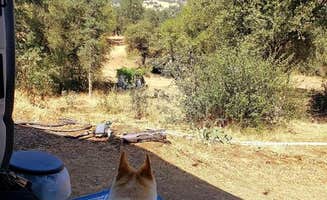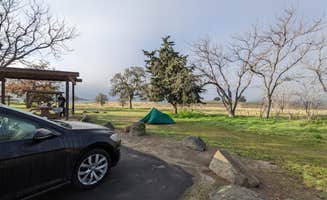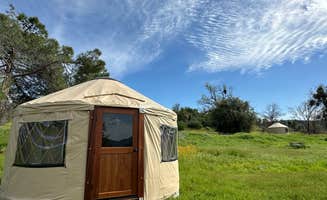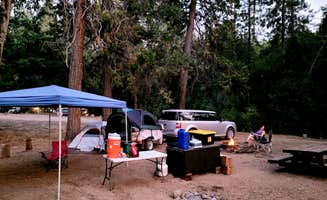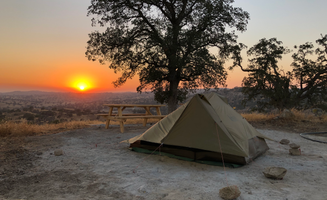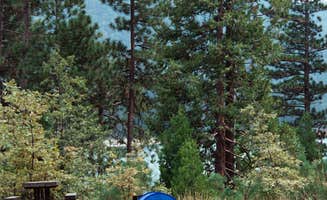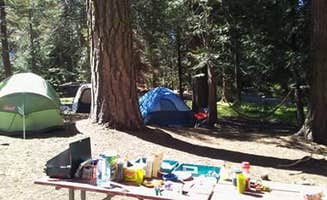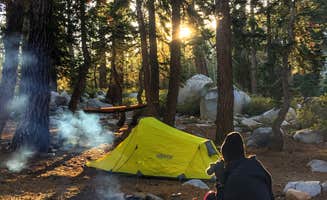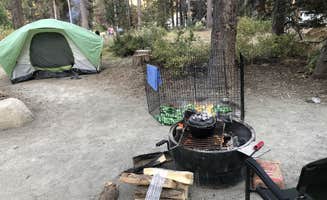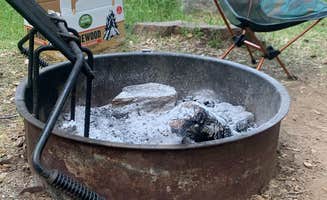Tent camping near Elk, California offers diverse experiences along the western foothills of the Sierra Nevada mountains, with elevations ranging from 1,200 to 4,500 feet. The region experiences hot, dry summers with temperatures often reaching 90-100°F between June and September, while winter camping requires preparation for occasional snow at higher elevations. Seasonal closures affect campground availability, with most primitive sites closing from November through April.
What to do
Hang gliding observation: At Dunlap Canyon Retreat, visitors can watch hang gliding and paragliding activities from a unique perspective. "There are people hang gliding and paragliding here which was super cool to watch both at take off (upper spot) and landing (main camp)," notes Courtney F. The property features both launch sites and landing areas.
Water recreation: Many campgrounds provide access to small lakes or rivers for swimming and paddling. Dunlap Canyon Retreat offers "a beautiful pond and hang gliding site" according to Martha H., while other visitors mention canoeing opportunities on the property's pond. Sites near rivers often provide cooling relief during summer months.
Hiking to viewpoints: The region offers numerous trail networks with varying difficulty levels. When camping at Little Yosemite Valley Campground, Kate W. recommends: "If you are attempting Half Dome you could exhaust yourself and hike up from base, or you could extend the trip and hike here first, stay a night, wake up early, and be the first on the Dome to watch the sunrise."
What campers like
Clean facilities: Well-maintained bathrooms and shower facilities rank high on camper satisfaction lists. At Crystal Springs Campground, Virgil O. appreciated that "restrooms are not too far & not too close to any site, flushing toilets and showers are not too far away located next to the John Muir Hotel."
Natural water features: Access to rivers or ponds enhances the camping experience for many visitors. Nyssa L. enjoyed Little Yosemite Valley Campground because they "passed out immediately in our hammock to the sound of the river next to the site." These water features provide both recreational opportunities and natural cooling during summer heat.
Wildlife viewing: Multiple campgrounds offer chances to observe local wildlife. At Camp Ikigai Animal Sanctuary, Rob H. describes "a working animal sanctuary with horses, chickens, ducks, dogs, humans, etc." The sanctuary offers a unique environment where "animals and humans living off grid in harmony."
What you should know
Road conditions: Access to many campgrounds requires navigating unpaved roads. Miguel M. warns about Bretz Mill Campground: "The road to get to campsite can get rough. It's a good 8 mile dirt road. Some parts are collapse. And others parts get muddy so make sure you got a good car."
Fire restrictions: Many Sierra foothill campgrounds implement seasonal fire bans during high fire danger periods. Always check current fire regulations before your trip, as conditions change rapidly during summer and fall months. Most established campgrounds with fire rings require campers to purchase firewood locally rather than collecting it.
Insects: Expect to encounter wasps and mosquitoes during summer months. Azizah T. reported at Crystal Springs: "Every time we brought ANY food out we were swarmed with wasps. It made the experience a bit unbarring." Miguel M. also noted "lots of mosquitoes around" at Bretz Mill Campground.
Tips for camping with families
Primitive tent options: Many campgrounds offer walk-in tent sites suitable for families seeking quiet experiences. At Ya-gub-weh-tuh Campground, Aliza N. explains: "Several sites with picnic tables and fire rings but all are walk in sites for tenters. Fee is $10/night." These sites typically require carrying gear a short distance from parking areas.
Animal interactions: Campgrounds with animal residents can provide educational experiences for children. Rob H. describes Camp Ikigai Animal Sanctuary's unique features: "Amazing outdoor shower has grapes and herbs growing in it. Laundry facilities and kitchen available in a welcoming community area."
Bear awareness: Campers should practice proper food storage, particularly in higher elevation sites. At Little Yosemite Valley Campground, Esther Y. advises: "Watch for bears ... they are common here." Most established campgrounds provide metal food storage lockers or require bear canisters.
Tips from RVers
Site accessibility: RV camping options are limited in this region, with most sites accommodating smaller rigs only. At Dunlap Canyon Retreat, Courtney F. notes: "We stayed at lower main camp with 30 ft RV, and had plenty of room... The sites have water and sewer hookups & when we stayed he had one spot with full electric but he is working on full hookups for all the sites."
Generator restrictions: Many campgrounds prohibit generator use to maintain quiet environments. Check specific campground rules before arrival, as policies vary widely between locations. Some campgrounds offer designated generator hours during midday to allow battery charging.
Parking limitations: At walk-in tent camping areas, parking is often limited. Manny R. observed at San Joaquin River Gorge that "the parking lot was completely full" during peak times, making early arrival advisable, especially on weekends.


